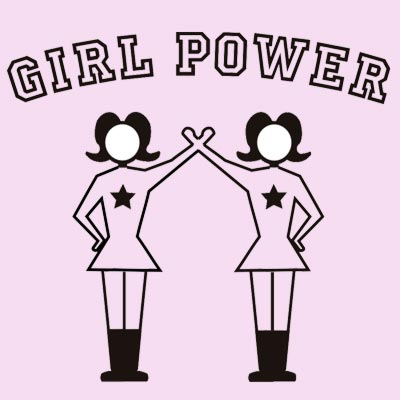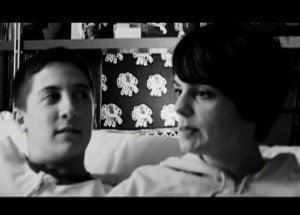
Girl Power: All Dolled Up traces the inception and development of the phenomenon that birthed the songs of Riot Grrl and the Spice Girls and fueled the writers of Buffy the Vampire Slayer: What is “girl power” and who defines it? Setting the candid responses of multiple young girls (aged 4-16) against the responses of women in academia, Sarah Blout Rosenberg makes visible the crushing effects of popular media and entertainment on the development of a female identity.
We are first introduced to the girls sharing what they believe “girl power” is. For Jasmine, 16, “girl power” is about equality: “Females can be powerful and they can do everything males can do.” Karen, 14, takes this a step further, asserting, “girls can do anything guys can do, sometimes they can do it better. And girls can do it differently.” The younger girls also chime in, seeing “girl power” as standing up for those being bullied or as Taina, 12 sees it “feeling good about themselves.” Sharon Lamb, EdD, Professor at the University of Massachusetts, then situates the phrase in a historical context, describing it as emerging in the 70s, a product of second wave feminism that sought to establish that girls could do whatever boys could do. For Carrie Preston, Assistant Professor at Boston University, the continued relevance of “girl power” is reflective of “the desire not to identify as the victim.”
Rosenberg is skeptical, however, of whether this modern-day politics of girl power is even empowering. We see Uma Thurman in a battle scene in Kill Bill, Angelina Jolie as Lara Croft in Tomb Raider, Ke$ha on a red carpet, Miley Cyrus gyrating in a music video, Katara waterbending in Avatar: The Last Airbender the series, Beyonce shakin it in “Single Ladies,” Superwoman, and finally Lady Gaga scantily clad in “Bad Romance.” Interweaving images of women that seem contradictory- Lara Croft and Ke$ha?- the film scrutinizes the very notion of what female empowerment is in popular media and the extent to which this new meaning of “girl power” has been co-opted.
Refreshingly, the voices of the young girls, speaking unabashedly about how they interact with media images of themselves, create the narrative. The younger girls giggle and share their desire to look beautiful all the time, how they relish shopping, and how they want to be princesses. The older girls, however, offer the most poignant critique: while they understand the “business” of it all, they admit they are still attracted to these products and stereotypes. As the level-headed Karen, 14, lamented: “Every girl wants to find Prince Charming. Every girl wants to have pretty stuff. Every girl wants everyone to love them.” Granted, this response is, as many others in the film are, a bit hetero-normative and generalizing. This is Rosenberg’s intention. By layering the voices of an ethnically diverse and wide-ranging group of young girls in terms of age, Rosenberg shows that no girl is exempt from these images and that each girl internalizes them.
While Rosenberg touches on the most widely critiqued and established offenders, Mattel (manufacturer of Barbie) and Disney (creator and disseminator of fairy tale stories of Princesses and Prince Charmings), Rosenberg contexualizes her analysis in the current moment, considering the impact MGA Entertainment (the manufacturer of Bratz), television programs, entertainment magazines, interactive online games, and musical lyrics have on young girl’s self-perception. In the business of making money, even Dora the Explorer falls prey to gendered commodification. When first aired, Dora was the best role model in toys and television for young girls, as she wore “shorts and not skirts” and was adventurous, inquisitive and determined. She has since then been co-opted; girls can buy Dora in the “kitchen, Princess Dora, Dora shopping kits, Dora makeup kits,” all items that “undermine” what she originally symbolized, Professor Lamb laments.
Arguably, it is Rosenberg’s cutting and fusing of seemingly endless multi-media examples that makes her critique powerful: visually, the viewer is so bombarded by commercials and magazine covers showing lip gloss, flowing hair and high heels, that he/she undeniably feels the omnipresence and power of these images. In these moments, the viewer departs from being a spectator to inhabiting the gaze of a young girl consuming the glitter and glam.
It becomes clear that these brands, only concerned with selling their products, teach girls a very problematic sense of “girl power”, one based on beauty, popularity, and approval by men. Girls seeking this sort of disabling empowerment learn another irreversible message: consumption of the right products can grant them happiness. As a scholar in the film puts it, this new sense of “girl power,” namely equating “girl power” with beauty, is oxymoronic. Having nothing to do with “behavior,” “action,” or “enacting change,” this new conceptualization sadly only offers girls a very hollow and temporary means of empowerment.
The documentary ends as it began: revisiting the notion of “girl power” and reinvigorating it. Highlighting female politicians like Michelle Obama and Hillary Clinton, Rosenberg offers an alternative role model to sex vixens like Kim Kardashian and Nicki Minaj. On a somewhat clichéd note, the girls then share their aspirations, and how they will use their best asset, their intellect, to become: a lawyer, veterinarian, engineer, graphic designer, midwife, teacher, and an artist. Rosenberg gives the last word to a scholar, who, resisting a polarizing classification of what it means to be an empowered woman, provocatively claims–, “the issue is not that you wear pink or are a cheerleader but that the world acknowledge you are more complex than just that.
The faults of Girl Power: All Dolled Up are undeniable– its subject matter is too overdone, the use of heart wrenching and candid responses of young girls is so cliché, its message is very one-sided, and it doesn’t delve very deeply into any of the themes it brings up. Where are the Spice Girls and their role in the resurgence of “girl power”? Where are the representatives from Mattel or MGA Entertainment to offer their side of the story? Why does she not incorporate more historical footage, counter-narratives, really any additional material that would make her argument more complex? In a review for the Buffalo Library, Kathleen Spring, a Librarian at Linfield College in Oregon, recommends the film but acknowledges it:
“is not significantly distinct from Susan Macmillan’s Girls: Moving Beyond Myth (2004), and the short documentary What a Girl Wants (2001) is a more compelling film of comparable length. Maria Finitzo’s 5 Girls (2001) and Jennifer Siebel Newsom’s Miss Representation (2011) provide fuller, feature-length treatment of the same subject matter; as such, libraries with these films in their collections may opt to pass on Girl Power.”
Paradoxically, while all of these arguments are leveled at the film’s relative simplicity, the film arguably addresses a mature audience. Making interviews with professors and multi-layered media the central devices of criticism, Rosenberg inadvertently ostracizes the young girls who inspired her work. Very young female spectators would maybe understand and identify with the young girls’ stories, but would lose the narration of the scholars and not be able to interpret the connection among the images Rosenberg fuses.
While all that may be valid, I cried throughout the entire short film. The young girl participants answer so candidly that it is impossible to not think back on one’s own childhood; wanting to be Princesses, loving shopping, going through puberty, and crushing on boys, their story was my story in undeniable ways. Rosenberg’s montage of blatantly sexist commercials really made the targeted nature of them visible and forced me to question whether I internalize and even find pleasure in the images of “femininity” the commercials espouse. Despite being about young girls, this short film should be watched by all girls older than 16 because in its limited and yet vivid exploration of the relationship girls have to popular media, it inspires internal retrospection and the mending and cultivation of one’s own, real girl power!
For more information please visit:



